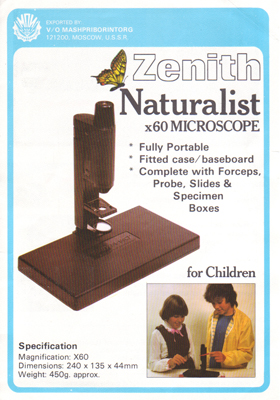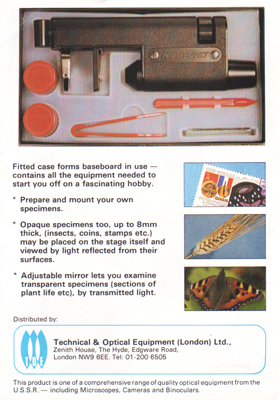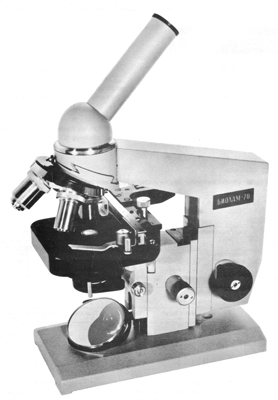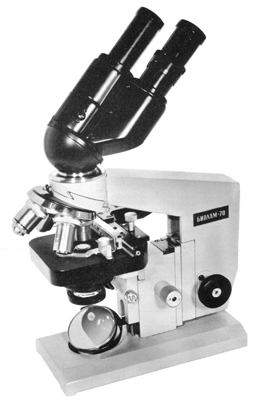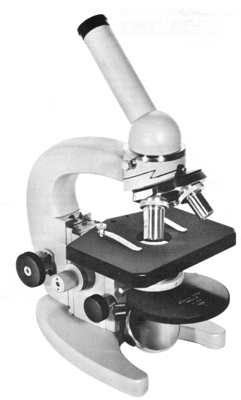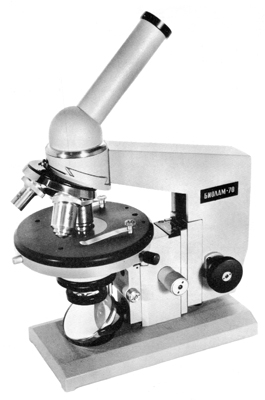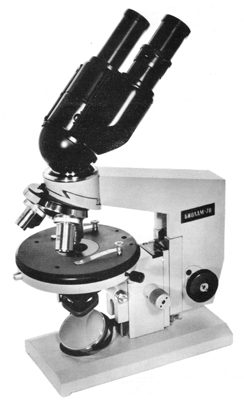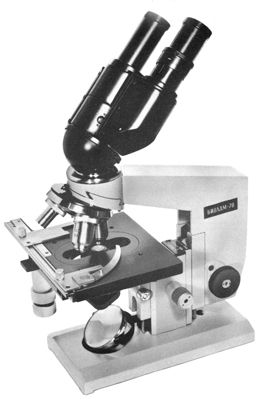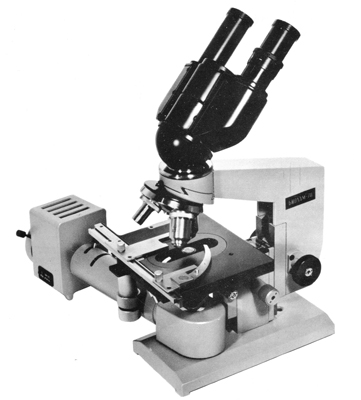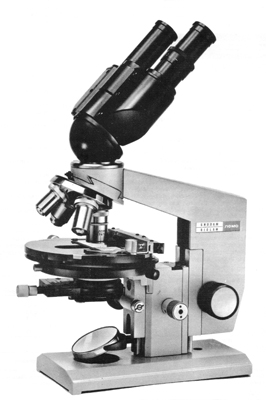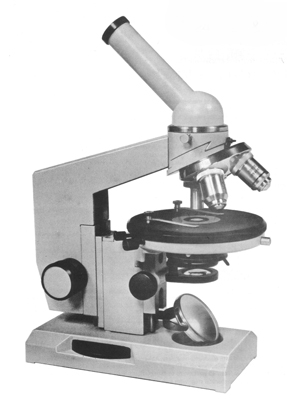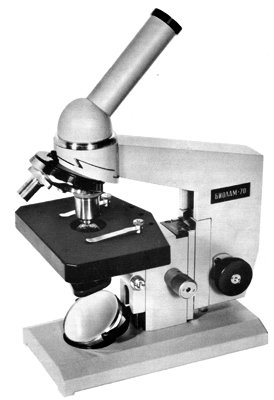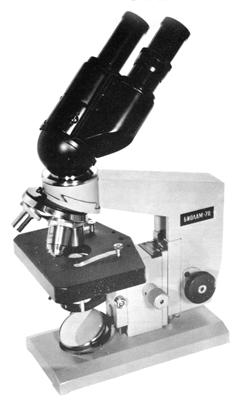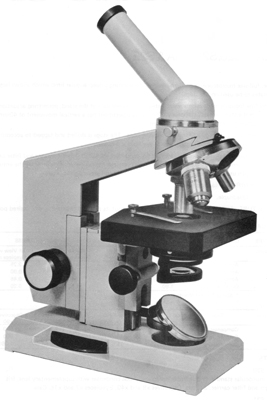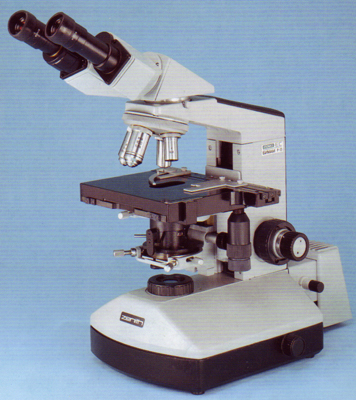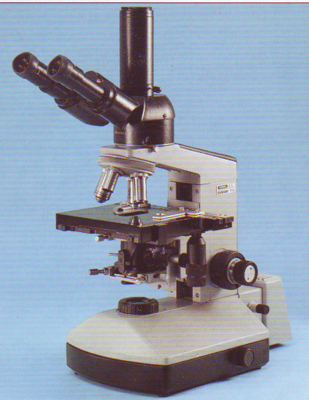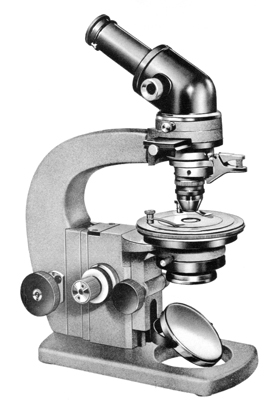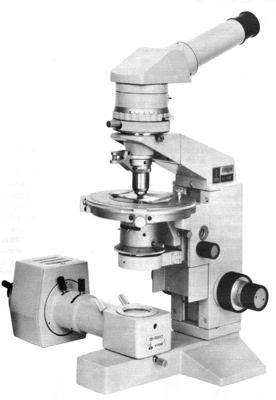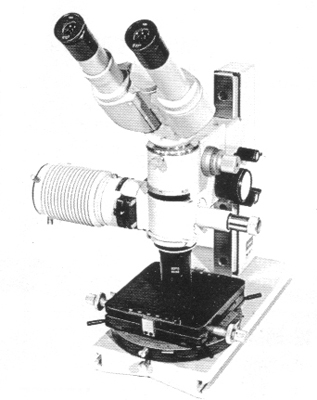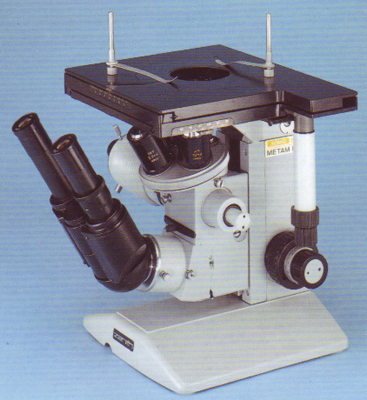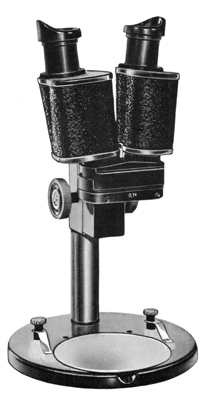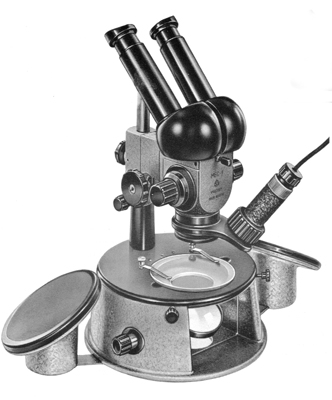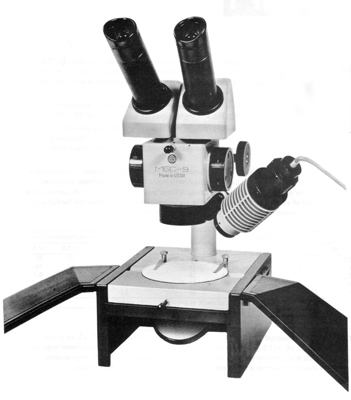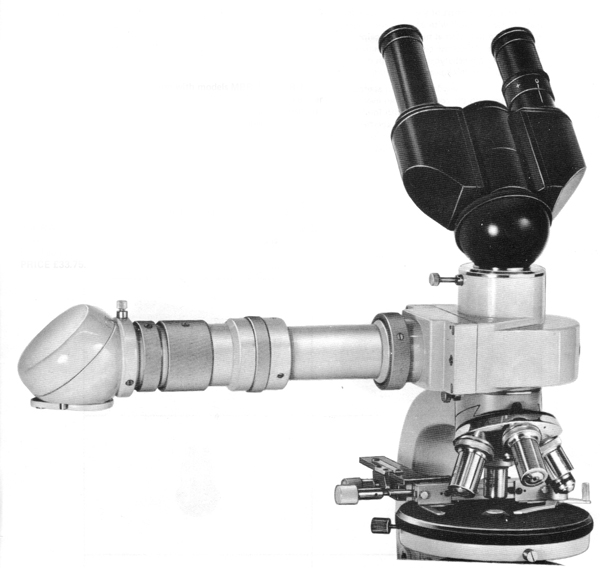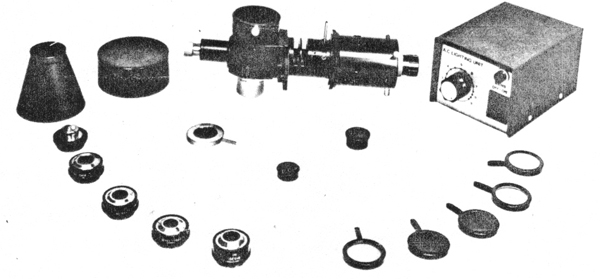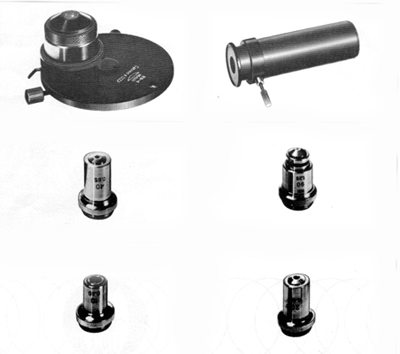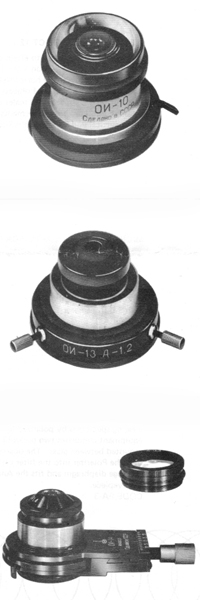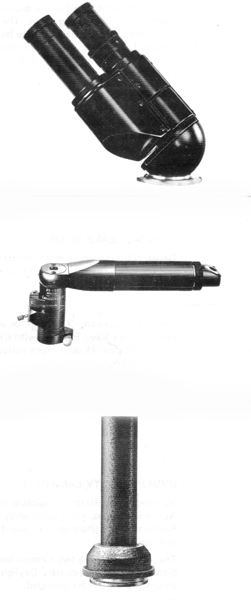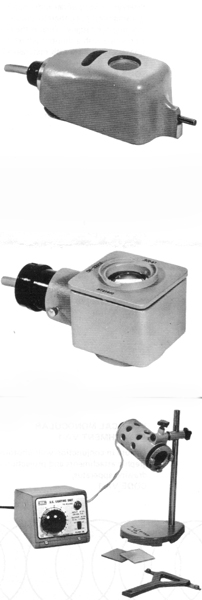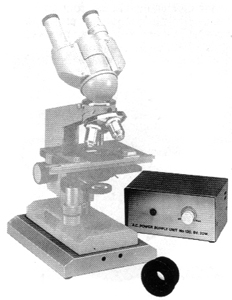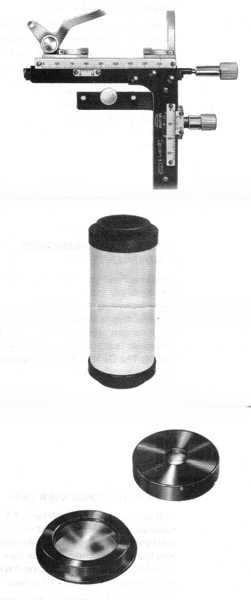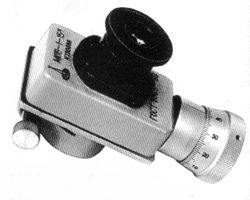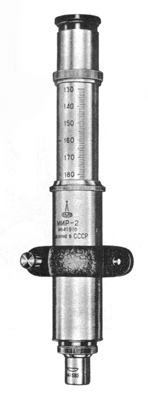Acknowledgements and credits: Technical and Optical Equipment (London) Ltd ('TOE') no longer exists at the last known trading address, but Zenith branded microscopes are continued and distributed in the UK by Optical Vision Ltd. The Director, Robert Crawford, has kindly given permission to share the Zenith data sheets and catalogue of the 'TOE' era. Thank you to Alfred Klomp for his website resources on 'TOE'. Thank you to David Howard for the 'Zenith House' photograph.
Like many photography and microscopy enthusiasts, I have a fond affection for the Zenith branded Russian optical equipment in the 1970s. My first proper camera (replacing a Kodak Instamatic) was a Zenith EM SLR—it wasn't elegant but built like a tank and a solid affordable workhorse. Similarly my first proper microscope (replacing a sturdy toy model) was a Zenith LOMO Biolam; like the camera, a good outfit was a two figure sum and widely available from photo outlets.
In these days of instant information access where most product data can be readily accessed online, I also affectionately recall the 'postal era'. Where a letter had to be penned to the distributor in the hope they would send some information; hopefully the handwritten letter wouldn't be dismissed as that of an enquirer with little money to spend! I eagerly awaited the fruits of my enquiry on the Zenith microscope range to TOE in the 70s and was thankfully rewarded with a reassuringly large 'thunk' on the doormat by a bulging envelope. They had sent data sheets on essentially their entire range.
The Zenith branded Russian microscopes remain a very popular microscope amongst hobbyists in the UK although believe no longer distributed here. They frequently turn up on eBay and can be a good value microscope. The range was quite extensive so the data sheets of the era may be of interest and are compiled below, along with comments on aspects of the range based on my own equipment built up over 30 years. The compilation doesn't claim to be complete, only covers the 1970s - 90s and my understanding of 'who made what' is certainly incomplete. I would be interested in other aspects of the range not mentioned and comments on queries raised.
Preliminary notes:
LOMO - is the Leningrad Optical and Mechanical Enterprise. The LOMO USA website has a timeline history of the now public limited company which notes they were founded in 1914 and are 'the largest optical manufacturer in Russia'. Also see the Wikipedia LOMO entry.
LOMO microscope model names (in UK) - Some types of stand had names, often seen on a limb label in Cyrillic. English equivalents were used to describe the UK models:
BIOLAM - biological stand,
BIMAM - an advanced biological stand,
METAM - metallurgical stands,
POLAM - polarising stands.
From the parent LOMO Russian website, the BIOLAM name seems to have been retained for a modern inverted microscope although a Google image search also show sophisticated research scopes with this name,
but the US current range of LOMO stands have different naming. For example, the modern equivalent to the UK Biolam (now with built in lighting and DIN optics) is sold as the Multiscope; Metam and Polam names are retained as well as LUMAM fluorescence models.
English sales and information literature on LOMO accessories invariably used an English phonetic equivalent of the Russian product code on the item itself. Thus the OИ-19 external lamp is referred to as the OI-19.
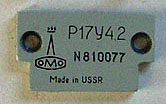 Dating LOMO microscopy equipment - The makers thoughtfully used the manufacturing year as the start of serial numbers. I believe by inspection of my own outfit, that this also applies to most, if not all, their accessories and objectives of the period. This
may
not necessarily apply to all Zenith branded microscope equipment, because not all were made
by LOMO, especially the more recent models. Image right, fine focus top plate of a Biolam, photo by Ian Walker. This example dated 1981. 'Р1У4.2' seems to be the maker's Biolam stand code, but haven't seen this used in TOE literature.
Dating LOMO microscopy equipment - The makers thoughtfully used the manufacturing year as the start of serial numbers. I believe by inspection of my own outfit, that this also applies to most, if not all, their accessories and objectives of the period. This
may
not necessarily apply to all Zenith branded microscope equipment, because not all were made
by LOMO, especially the more recent models. Image right, fine focus top plate of a Biolam, photo by Ian Walker. This example dated 1981. 'Р1У4.2' seems to be the maker's Biolam stand code, but haven't seen this used in TOE literature.
Identifying the maker of a 'TOE' sourced Russian microscope - The LOMO manufactured microscopes I've handled or seen in the TOE literature have all  had the distinctive LOMO logo, (see photo above right) and/or LOMO name in Cyrillic on the model label. (On the printed LOGO, see Russian LOMO website, a sailing ship surmounts the 'peak' of the logo). I have never handled a Russian stereo microscope in the MBS-x range but am uncertain if these were made by LOMO. From MBS-9 and 10 photos they
clearly
state 'Made in Russia' but have a logo with red circle with a 'C' in a triangle and circle (shown right); some I've seen sold on the web also have a logo of black anvil with four circles above. Is this the logo of another maker?
had the distinctive LOMO logo, (see photo above right) and/or LOMO name in Cyrillic on the model label. (On the printed LOGO, see Russian LOMO website, a sailing ship surmounts the 'peak' of the logo). I have never handled a Russian stereo microscope in the MBS-x range but am uncertain if these were made by LOMO. From MBS-9 and 10 photos they
clearly
state 'Made in Russia' but have a logo with red circle with a 'C' in a triangle and circle (shown right); some I've seen sold on the web also have a logo of black anvil with four circles above. Is this the logo of another maker?
Update March 2011: Thank you to Dimitrij who emailed and remarked: "You were in doubt whether the MBS-9 microscope with this logo [Right] was made by LOMO or some other microscope/optics maker. It is in fact made by another company called 'Lytkarino Optical Glass Factory', they have their web page on the Internet both in English and Russian: http://lzos.ru/en/index.php ". This website does indeed show this logo, and they currently sell the MBS-10, the current model. Extensive specs. and Russian manual are also offered.
Mashpriborintorg - Some Russian microscope literature has this company name and logo on (e.g. the Zenith 'Naturalist' leaflet). I believe their role was as exporter and not as manufacturer; their own website information (link is to English page) and Wikipedia entry corroborates this. Ref. 1 in the Wikipedia entry gives a link to a colour magazine in English 'MashPriborIntorg 42' hosted on the USSRPhoto.com website, which shows their range of still and cine camera exports, also photos inside the TOE, UK facilities.
Technical and Optical Equipment (London) Ltd - Their 1996-1997 UK catalogue states they started in 1962; this is the last TOE labelled catalogue I have. I'm not sure when and why the company ceased; the style of some microscopes in the late catalogue suggests they started to source models wider afield than Russia.
An illustrated article on 'Alfred's Camera Pages' by Alfred Klomp gives a fascinating insight into the company. He includes an extract from the book 'Discover Rewarding Photography. The Manual of Russian Equipment' written by Ronald Spillman (1971, publishers TOE) which he notes 'contains rare information about TOE's business and structure' and photos of their facilities. This book is widely available secondhand from about £0.60 (eBay and Abe) so was encouraged to buy my own copy. The five page 'The Company' section suggests that the Russian microscopes which TOE imported were also checked and inspected before distribution to dealers. Ronald Spillman in the book also briefly covers photomicroscopy with Russian equipment and shows a Zenith Biolam MBR microscope with Zenith E camera attached. (Alfred Klomp reviews the book here.)
'TOE' 'product codes' - TOE offered a wide variety of outfits based on the BIOLAM stands and these were referred to by an alphanumeric 'product code' on the data sheets and price lists. For convenience of cataloguing, the stands are categorised below using these codes. If buying a used example, it may be tricky knowing what the original outfit was, as the stand isn't marked with this code and an outfit may have been amended / extended at a later date.
'Zenith', 'Zenit' branding - From the 1970s - 90s TOE literature possessed, the 'Zenith' brand in the UK encompassed optics from various sources, including LOMO microscopes and the Zenith SLR range, the latter being Russian 'Zenit' models made by KMZ (see Wikipedia 'Zenit' entry). From the TOE 1996/97
catalogue, a 'Zenith' label was added to the front of base (whether LOMO
sourced or elsewhere), none of the earlier late 70s data sheets possessed show this.
As remarked in the credits, ' the 'Zenith' brand continues in the UK with various microscope stands offered via the distributors Optical Vision and its dealer network. The author is uncertain of the makers of the current range.
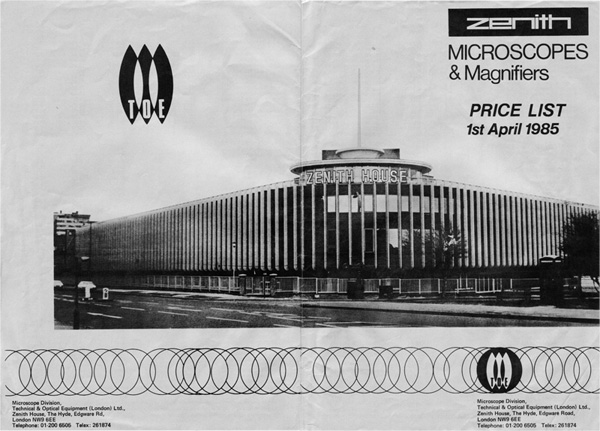
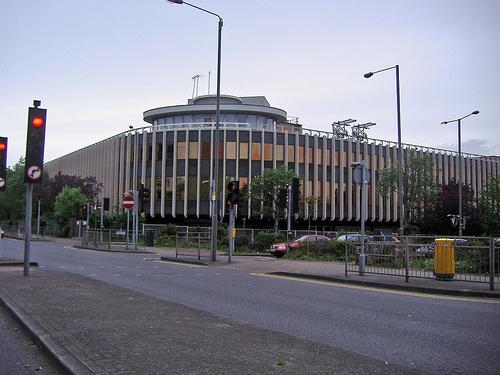
Left: Zenith House, a later address of Technical and Optical Equipment (London) Ltd. This price list also shows the 'Zenith' logo often seen on later microscopes and the 'TOE' logo. Full address up until at least 1996/7 - "Microscope Division, Technical and Optical Equipment (London) Ltd., Zenith House, The Hyde, Edgware Road, London NW9 6EE."
The section 'The Company' at the rear of Ronald Spillman's book published by TOE in 1971, notes that it was a new building 'designed specifically for Technical & Optical Equipment's function' with layout designed for specific requirements including 'Service and Inspection'. They also note that the company's motto was 'Priority Service'.
Right: Zenith House photographed by David Howard from his flickr page and shared with his permission, with thanks. David notes that by July 2008 the building had been demolished, which as he also remarks, seems a pity.
Microscopes and accessories
* indicates an illustrated two page A4 data sheet is available in the downloadable compilation.
** indicates an illustration and brief spec. in the four page brochure (see below).
Images are scans from the data sheets; brief specs are from the data sheets.
'Junior' microscopes
|
YWM-1* |
SHM-1* |
MBU-4* |
|
|
The optical outfit was the same as the YWM-1. All these junior microscopes had 'click stop' 'aperture controls' rather than condenser, so performance would be restricted to lower powers. |
A more advanced stand with coarse and fine focus, same optical outfit. The lack of a turret restricts their practicality, but could be a useful low power field microscope if a used example was found, as all these models use RMS objectives with standard eyepiece tube. |
|
Right: Zenith Naturalist with 60x fixed mag. The fitted case shown formed the base board. I've never handled one but looks a neat design, perhaps with a potential for field use, as well as for youngsters. Guido Santacana and Manuel del Cerro wrote a paper for the Journal of the Microscope Historical Society on this model entitled 'The Naturalist: A Russian toy microscope'. Volume 11.3.
|
|
|
Biolam microscopes
These LOMO made stands were offered in a wide range of outfits, usually supplied in a fitted wooden box, or metal case if a field model. They were focussing limb models with pre DIN 33 mm objectives and 160 mm tube length. The optics and earlier examples of the stand were based on a Zeiss Jena design (see Resources). It still remains an excellent affordable and expandable workhorse. See Resources for articles on various aspects of the product range and home servicing, notably the seized grease that may be found on used neglected stands.
The data sheets of the late 70s encompass some of the style variants often seen at this time:
Limb - either a curved limb reminiscent of the Zeiss Jena stand it was modelled on, or the more distinctive angular design.
Fine focus - the side acting fine focus knob, driving a 'clock work' module, or the base mounted disc focus, which had a fine screw with hardened pin acting on the fine focus assembly counteracted by a spring.
Coarse focus - A black disc knob were seen on some stands, others used a thicker black design with painted end disc.
Paint - later 70s models invariably had a pale green paint, earlier models and some later models had a grey paint, e.g. the MPD-1 polar stand. Both matching green and black binocular heads were offered in the outfits.
Labelling - The LOMO logo, serial number (and thus manufacturing date) was inscribed on the fine focus top plate behind the stage (see earlier photo).
A label, usually on the side of limb typically had LOMO and stand name in Cyrillic.
Some stand labels and data sheets described 'Biolam 70' stands, I'm not clear what the significance of this '70' model no. was.
Biolam, TOE product code 'D' and 'MBR'.
|
D10, D11, D11W* |
D13* |
MBR-IES-PHS* |
|
The 'D' range was based on the thick square stage shown with attached mechanical stage CT-12. Objectives supplied 9x plan, 20x, 40x, 90x OI. Three eyepieces 7x, 10x, 15x with Abbe condeser and plano concave mirror. The D11W had the water immersion 40x objective. |
The binocular variant with AY-12 head. Paired 7x and 10x eyepieces supplied. |
The phase contrast microscope on the curved limb stand, with thinner stage and the KF-4 phase contrast outfit (see accessories below for spec.). No CT-12 mechanical stage supplied but all Biolam stages could take this accessory using the two stage clip pin holes and central threaded hole. |
Biolam, TOE product code 'R'.
The wide variety of 'R' outfits were based on the circular, centering, rotating stage. Supplied with the Abbe substage condenser in all outfits except the top of the range. Some of the cheapest outfits had the rotating stage and was ideal for the enthusiast looking for an affordable stand with potential for polar or photo work where a rotating stage was valuable. The author's own stand was an R10, purchased in 1979 for £76 from Youngs of Leicester and extended over the years with additional LOMO optics and many of the accessories. My brother and I have also bought, serviced and resold used examples of a variety of the other stands. The range includes the flagship R17, R27 fitted with apochromatic objectives and aplanatic condenser—the model data sheet I drooled over but couldn't afford! (The R27 was £543 inc. VAT in 1985, a tidy sum.)
|
R10, R11* |
R13* (shown), R23** |
R15* (shown), R25** |
|
The monocular outfits with rotating, centering stage. The data sheets refer to a number of these stands as 'Biolam 70' and seen on black limb label in Cyrillic. Note black serial no. plate. The R10 was supplied with 8x and 40x objectives with 7x and 15x eyepieces. The R11 added the 90x OI objective. (OI = oil immersion.) |
The binocular variant with AY-12 head, objectives as R11. Paired 7x and 10x eyepieces supplied. |
Described as an 'advanced' microscope, it featured the excellent integral mechanical stage with drop down controls. Optics as R13. |
|
R16* (shown), R26** |
R17* (shown), R27** |
R21, R22, R24 (shown)* |
|
As R15 with the OI-35 Köhler illuminator with 8V 20W lamp. The lamp is best setup the other side, as shown it interferes with the stage controls. Also included a 7x micrometer eyepiece. |
Described for use in 'laboratories and research establishments'. Although this lacks the lamp, it is optically the most highly specified outfit. With four apochromatic objectives (10/0.30, 20/0.65, 60/0.70-1.0 OI, 90/1.30 OI) and 90x achromatic. Aplanatic / oblique OI-14 condenser and integral mechanical / rotating / centering stage. Paired 5x, 7x and 10x compensating eyepieces supplied. Also a 7x graticule eyepiece and x15,
x20 photo eyepieces. |
Similar outfit optically to the R13, except disc focussing in base, the more modern coarse focus knob and matching bino' head. R21 - Three objectives 8x, 40x, 90x OI. Two eyepieces 7x and 15x. |
Biolam, TOE product code 'S'.
The 'S' outfits featured the deeper rectangular stage and were supplied with stage clips rather than the CT-12 attachable mechanical stage of the 'D' range above.
|
S10, S11, S12* |
S13, S14* |
S20, S21, S21A, S22* |
|
The S10 was supplied with 8x and 40x objectives with 10x and 15x eyepieces. The S11 added the 20x objective and 15x eyepiece. The S12 further added the 90x OI objective. |
The binocular variant with AY-12 head. Paired 7x and 10x eyepieces supplied. The S13 was supplied with 8x, 40x, 85x WI and 90x OI objectives. The S14 was as for the S13 without the 85x WI objective. |
Similar to the S10 with the variant with disc focussing and modern coarse focus knob. The S20 was supplied with 8x and 40x objectives with 7x and 15x eyepieces. The S21 added the 20x objective and 10x eyepiece. The S21A further added the 3.5x plan objective. The S22 was as the S20, plus the 90x OI objective and 10x eyepiece.
|
Research microscope BIMAM R-13
I believe that LOMO, given the company's size, would have made a variety of research microscopes, but to my knowledge this was the only research model with integrated lighting available from TOE in the UK in the 1970s - 90s; it was illustrated and described in the 1996/97 catalogue and cost £799 exc. VAT. This was a moving stage design (cf Biolam moving limb) fitted with more modern 45 mm DIN objectives. Described in the catalogue as 'a high performance compound laboratory microscope of modern and ergonomic design'.
My brother Ian and I jointly owned one of these for a while (spotted in an engineering warehouse clearout sale for a modest sum). The engineering was good and the focus excellent. For us, it wasn't a 'keeper' because of the lack of compatible accessories in the UK. The dovetail substage did not match the sleeve mount accessories for the LOMO Biolam range. The phase outfit for example was 'price on application'. The model did share the MFN-11 trinocular head, also used on the Biolam. In fact its bulk seemed better matched to this stand.
The condenser was an achromatic NA0.9 in centering Ackhurst mount. Four achromatic objective supplied, 4x, 10x, 20x, 40x and 100x OI. The lamp was a 6V 20W Köhler unit.
The Laboroscope model currently offered by LOMO USA seems to share features from this model, including the dovetail condenser mount and where substage condenser options are available. Alessandro Bertoglio favourably reviews the Laboroscope on his excellent website.
|
'EC BIMAM R-13 binocular research laboratory microscope' |
with MFN-11 trinocular head |
POLAM - polarising stands
|
MPD-1* |
POLAM C-112* |
|
'Field polarising microscope' supplied in a metal carrying case. An elegant model based on an earlier curved limb LOMO stand. Greg McHone in his Micscape article on polarising microscopes, shows a similar style stand in field case, the 'MIN-1', perhaps the latter was an earlier version. |
An impressive highly specified model. It had a three page TOE data sheet. The '96/97 catalogue (£850 exc. VAT) shows the 'Zenith' logo on limb front. LOMO USA currently sell a POLAM-P model. |
METAM - metallurgical stands
|
METAM P-1* |
'EC METAM RV-21 inverted metallurgical' |
|
A metallurgical stand with top lighting. Supplied with 8x, 12x, 31.7 planachromatic objectives and six magnifications of eyepiece. |
An inverted model with 'DIC module'. Image and spec in 1996/97 catalogue. £850 exc. VAT. |
Stereo microscopes
As remarked above, I'm uncertain if these Russian stands were made by LOMO.
Update March 2011: See preliminary notes section for new information regarding the maker of the MBS-9 and MBS-10.
|
BM-51-2* |
MBS-1* (shown) and MBS-2* |
MBS-9* (shown) and MBS-10 |
|
'A robust, simple model e.g. for the field and schools. Fixed mag. of 8.75x. |
A design reminiscent of some Zeiss models. The MBS-2 was the boom variant. Rotating five mag drum from 0.6 - 7x. |
These are very popular and well regarded models. Rotating five mag drum from 0.6 - 7x. Like the MBS-1, the lamp can be attached to the base for transmitted work. |
BIOLAM stand accessories
|
RA-6 'Projection and camera lucida attachment'. A well engineered looking accessory, supplied with a variety of filters in a fitted wooden box. |
|
OI-21 'Reflected light illuminator'. An extensive outfit with 6V 20W lamp. Four epi-objectives supplied (9x, 21x, 40x, 95x OI) and 95x OI achromatic. The power supply shown was a UK TOE specified supply also supplied with OI-19 and OI-35 lamp. The Raf Camera website has an English translation of the OI-21 manual with scans of the manual pictures. The modern equivalent epi outfit offered by LOMO USA is the EA-5. |
|
KF-4 'phase contrast apparatus'. Supplied with four phase objectives, 10/0.3, 20/0.40, 40/0.65 and 90/1.25 OI. The KF-2 outfit came just with the 10x and 40x objectives. Supplied in fitted wooden box with green filter and phase telescope. |
|
OI-10 light and darkfield condenser.
OI-13 darkfield oil-immersion condenser. NA 1.2 and can be used for dry and oil immersion objectives. A funnel stop was supplied (often lost in used examples) to restrict the NA of 90x objective. In centering mount and supplied in fitted box.
OI-14 aplanatic / oblique condenser. In the author's view, after the bino head and mechanical stage, this is the single most beneficial accessory to add to a Biolam stand. It gives superior performance to the supplied Abbe condenser. |
|
AY-12 binocular head. Supplied as standard with many stands and as an accessory in a fitted card box; included with paired 7x and 10x eyepieces. Often seen in black as shown and the green Biolam stand paint.
AY-14 demonstration attachment. For dual observation, the '10x eyepiece clamps onto the microscope tube'. It has a movable pointer.
VA-1 vertical monocular attachment. For photomicrography, projection and drawing work. It is the author's preferred attachment for photo' work with a live view camera, as simplest setup for critical work. |
|
|
SL-4 substage lamp. A basic lamp to replace the gimballed mirror, mains 15W bulb driven. Not for serious work or the safest option for wet microscopy and/or use with youngsters.
OI-32E substage lamp. A better design to sit in microscope base with mirror removed. Has condenser lens. Mains driven 15W bulb.
OI-19 'high intensity lamp'. Features a two element field lens, field iris, filter slot and focussing 8V 20W lamp. The author's default lamp for my Biolam stand. HLS-1 attachable halogen illuminated base. Designed to be used with the rectangular base Biolams. It shone light through base port with mirror removed. A 6V 20W halogen bulb with diffused condenser for base. |
|
CT-12 mechanical stage supplied in a fitted wooden box. An invaluable addition to a Biolam stand if not supplied. Can be used with care with the rotating stage but will hit limb in some orientations. Some modern Asian designs are essentially the same and will fit a Biolam stand.
CA-3 'micro-camera adapter'. This allows an eyepiece to be inserted and replaces bino' or mono' head. Has an M42 Praktica screw thread for the Zenith SLR camera bodies or other models with this thread.
PA-3 polariser and analyser. The polariser fits in the condenser filter carrier, the analyser sits over the eyepiece. OK for basic studies but not ideal as the head prisms can depolarise to some extent. It is better to insert an analyser at base of bino' or mono' head, i.e. before the prisms.
MOB-1 x16 'screw micrometer eyepiece'. |
|
Brinell and measuring microscopes
|
MPB-2 Brinell microscope* |
MIR-2 (shown), MIR-3 measuring microscope* |
|
Uncertain if made by LOMO. Data sheet states it is 'designed for measuring the diameters of indentations made by the Brinell hardness tester and may also be used for measuring the surface features of objects within an area of 6.5 mm diameter'. Total magnification 24x, focussing eyepiece with measuring scale. |
LOMO branded. Standard RMS objective thread supplied with 3.7x objective and 7x focussing eyepiece with scale and graticule. The 130 - 190 mm tube length allowed the measured value per division to be changed. Measured 0.015 to 6 mm 'in length or separation'. |
Downloadable information (for personal use only, not for further distribution or sale). Acrobat® pdf files of jpeg images of 150 dpi scans.
Compilation of TOE 'Zenith Microscopes and Accessories' A4 data sheets, ca. 1976. 11 Mbytes.
'Zenith Microscopes and Accessories', ca. 1980s. A4 4 page overview of entire range.
TOE 'Zenith Microscopes and Magnifiers' Price list, 1st April, 1985 price list. A4, 4 page.
TOE leaflet 'Zenith Magnifiers and Measuring Instruments' also 'Zenith Naturalist'.
TOE 'Zenith Microscopes UK Catalogue 1996/7'. A4 colour, 12 pages. 5.5 Mbytes.
TOE 'Optical and Photographic Products'. Included for completeness. Shows the 'Helios' binocular and spotting telescope range, Zenith 122 SLR and Lubitel 166U TLR camera. (TOE address when issued: Zenith House, 69 Lawrence Road, Tottenham, London. N15 4TG)
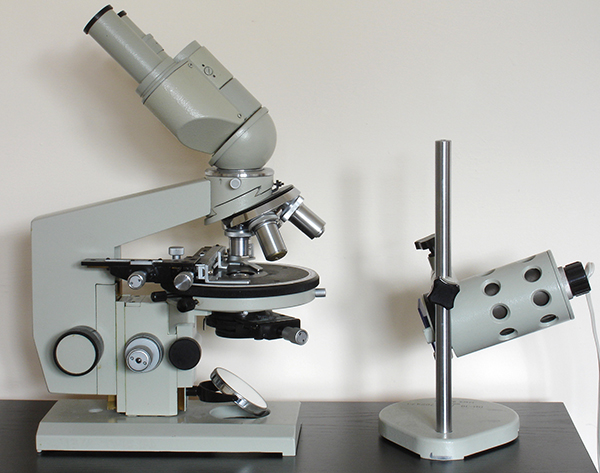
The author's LOMO Biolam made in 1978 started out in the 70s as the monocular R10 outfit but has been added to over the years with bino' head, aplanatic condenser (shown here), phase outfit and mechanical stage, plus a range of the more exotic LOMO objectives. The LOMO OI-19 lamp is shown.
Comments to David Walker welcome.
Resources
A compilation of LOMO microscope resources on Micscape - written by users of the stands, includes articles on their use, servicing, modifications and tips.
The LOMO Biolam microscope - an illustrated overview by Ian Walker.
About.com: Web Design / HTML - HTML codes for Russian (Cyrillic).
Microscopy UK Front Page
Micscape Magazine
Article Library
© Microscopy UK or their contributors.
Published in the August 2010 edition of Micscape Magazine.
Please report
any Web problems or offer general comments to the Micscape Editor,
via the contact on current Micscape Index.
Micscape is
the on-line monthly magazine of the Microscopy UK web
site at Microscopy-UK
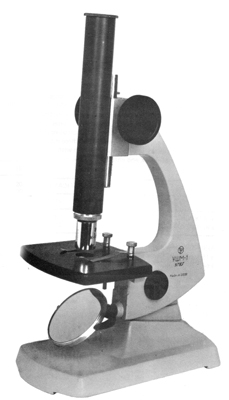
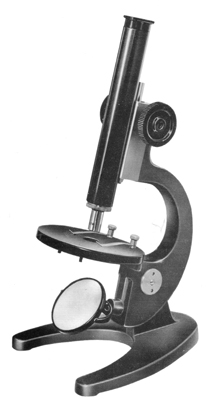
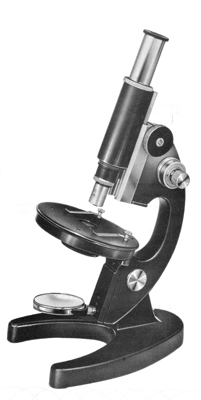
 Two objectives, an 8x and 20x were supplied with three eyepieces 7x, 10x, 15x. All models shown had die cast limbs. Although Russian, the logo suggests this and perhaps the other 'Junior' models were not made by LOMO.
Two objectives, an 8x and 20x were supplied with three eyepieces 7x, 10x, 15x. All models shown had die cast limbs. Although Russian, the logo suggests this and perhaps the other 'Junior' models were not made by LOMO.